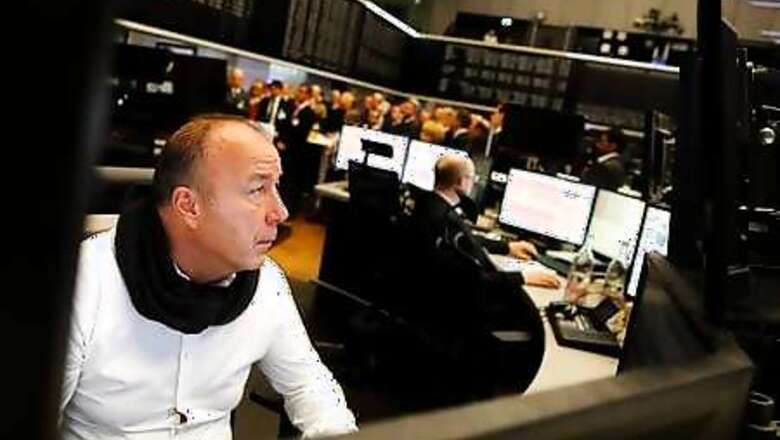
views
LONDON: The Japanese yen surged and stocks fell on Friday after Prime Minister Shinzo Abe resigned for health reasons, while broader share markets were mixed as investors worried about a lack of detail in the U.S. Federal Reserve’s policy shift.
The Nikkei 225 share index closed down 1.4% while the yen soared more than 1% after Abe announced his resignation, saying he would stay as prime minister until a new leader was appointed.
There has been speculation about Abe’s health all week but the resignation of Japan’s longest-serving premier rattled investors given he has spearheaded efforts to revive growth through his reflationary “Abenomics” policies.
The yen, seen as a safe-haven currency to buy in times of uncertainty, jumped 1.2% to 105.33 yen per dollar, putting it on course for its biggest one-day jump since March when the coronavirus pandemic roiled global markets.
Some analysts said the yen’s rally seemed excessive given that, while there was uncertainty, Abe’s successor was unlikely to alter economic policy significantly because the country remains in the middle of a battle to avoid deflation and lift growth.
“Of course it is unclear what kind of policy his successor will pursue. But realistically: There is unlikely to be a major change – especially in the direction of a much more restrictive policy”, said Thu Lan Nguyen, a currency analyst at Commerzbank.
Japanese markets react to Abe resignation https://fingfx.thomsonreuters.com/gfx/mkt/rlgvdoorzpo/Japan2808.png
It was a mixed day for stock markets elsewhere as investors continued to digest the Fed’s widely-awaited shift in its policy framework, which was unveiled on Thursday and saw the central bank place more emphasis on boosting economic growth and less on worries about inflation running too high.
The policy aims for 2% inflation on average, so too slow a pace would be followed by an effort to lift inflation “moderately above 2% for some time.”
Stocks initially jolted higher as investors bet interest rates would remain low for longer and more stimulus was likely.
But share markets have since been choppy, with some traders disappointed the Fed did not reveal more details about how the new framework would work or provide clues as to what it will do at its next policy meeting.
“It’s not so much about what to do about inflation when it comes but about getting inflation above target. The challenge is to get inflation up to target and not very much was said about that,” said Colin Asher, a senior economist at Mizuho.
The Euro STOXX 50 was last down 0.21%, while Germany’s DAX slid 0.3%. Britain’s FTSE 100 was flat.
U.S. stock futures clawed their way higher and back to near record levels after earlier volatile trading on concern about the impact of a hurricane that struck the centre of the U.S. oil industry. S&P 500 e-mini futures was were last up 0.24% , a seventh straight day of gains.
Asian shares outside of Japan limped higher, with the MSCI’s broadest index of Asia-Pacific shares outside Japan gaining 0.22%.
DOLLAR DECLINE DEEPENS
In currency markets, the dollar extended an earlier drop and was 0.8% lower against a basket of other currencies by 1115 GMT, taking it back towards its lows of last week – which saw the dollar at its weakest since early May 2018.
The greenback has fallen sharply since June as many analysts are predicting more pain ahead if U.S. rates are to stay low for longer and amid political uncertainty before the U.S. presidential election in November.
The euro seized on the dollar’s weakness to gallop another 0.7% higher and was last at $1.1905, close to a more than two-year high it recently touched.
The 10-year U.S. Treasury yield rose to as high as 0.789%, the most since June 10, which caused the yield curve to steepen, reflecting the Fed’s tolerance for higher inflation. It was last at 0.752%, up 1 basis point on the session.
Crude oil prices see-sawed as a massive storm raced inland past the heart of the U.S. oil industry in Louisiana and Texas without causing any widespread damage to refineries.
Brent crude rose 0.09% to $45.13 a barrel. U.S. West Texas Intermediate (WTI) crude edged 0.23% higher to $43.14 per barrel.
The spot gold price bounced 1.49% to $1,957 an ounce. The precious metal tends to perform well when the dollar is weak and the Fed sends a dovish message on the future path of interest rates.
(Additional reporting by Sujata Rao in London; Editing by Kirsten Donovan and Mark Potter)
Disclaimer: This post has been auto-published from an agency feed without any modifications to the text and has not been reviewed by an editor




















Comments
0 comment